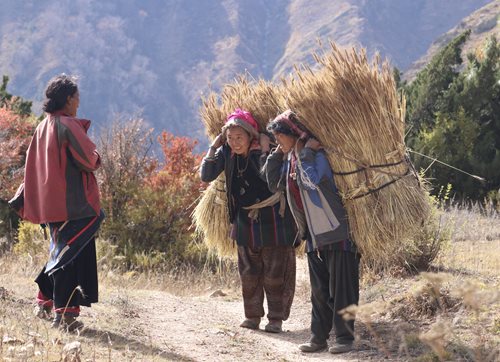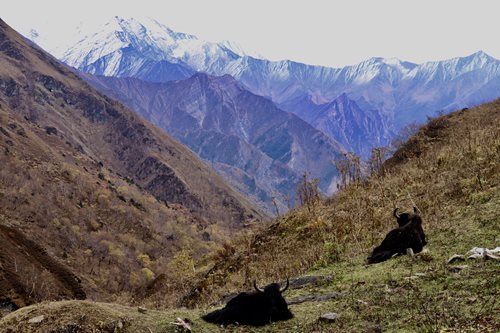Five days after leaving Dolpo’s capital we awoke in Ringmo to discover it had snowed overnight, rendering an already wonderful landscape even more magical, but then I started to consider how this would make treacherous paths even more challenging. The sun had been so warming thusfar but it was now also very cold. We were keen to start walking – to stimulate a bit of blood circulation. I decided to walk most of the descent from Phoksundo lake.
We retraced our steps down and through the village of Chunuwar where S spotted a herd of at least 13 blue sheep. When we pointed them out to a group of Nepalis who were coming in the opposite direction they were strangely uninterested – even when we offered them our binoculars.
We’d been really impressed on this trip to see so many domestic tourists. When we last lived in Nepal in the 1990s Nepalis just didn’t travel for pleasure, or trek simply to enjoy the mountains. Now though there we innumerable middle-class locals enjoying the challenge, taking selfies galore. Many carried expensive Canon cameras. Most were listening to music; wildlife wasn’t part of their scenery.
Our midday rice-stop was at the Hotel Samanjana where vultures circled and a very unshy pika was busying about. Once fed, we stomped across a small unprotected bridge to the western side of the river and tacked up and into a side valley.
The approach to the community of Pungmo was announced by a series of somewhat dilapidated stupas with fine religious paintings inside. The scene of the traditional flat-roofed village was enhanced by stings of colourful prayer flags. The landscape here was flat enough to allow people to cultivate barley and pretty much everyone was busy cutting and bringing in the harvest. Despite this being a relatively broad valley though, the sun disappeared behind the mountain ridge at 2.30pm, and the cold returned.
Pungmo is on the route to the important settlement of Jumla and so boasts a hotel, but a hotel with no chairs. The running water was at the tapstand. A flight of about 30 sarus cranes flew over high, forming and reforming patterns as if communicating some important message or symbol. They were heading for China.
We were grateful to be able to huddle around the central cooking fire and observe how little even relatively well-off Nepalis possess.
That evening some outsiders joined us and told the locals that their swastikas were back to front. Our host disagreed, explaining that theirs was the original Bon religion. Unlike Buddhists they encircled stupas anticlockwise and their swastikas were also anticlockwise.
We found ourselves enticed by the idea of knowing more about this remote high route into the extreme north-west of Nepal and resolved to walk along the beginning of this trail.
Our guide, Pemba, organised a picnic of chapattis. We asked about what might be available to add to our lunch. We were offered salt tea in a flask and our hostess managed to find four eggs, which she hard-boiled for us. So on this our 6
th day we set off wandering past busy villagers and through what appeared to be an abandoned village, where the residents of Pungmo would move to once the barley harvest was in, and then the yaks would be brought down from the high pastures. We walked what turned out to be a twelve kilometre, 500m climb through forests of massive silver birch turning autumn golden or between pines, hemlock and junipers hopping with hyperactive birds. The pastures were grazed with yaks. At the highest point, at around 4000m, we could see snow covered himals on three sides and if the mountain ridges hadn’t been so close we would have been able to see the Himalayas at all four points of the compass.



If you wish to read about this trip from the beginning, episode one is here
Pony trekking in Nepal
The next and final installment is here
Yak pastures